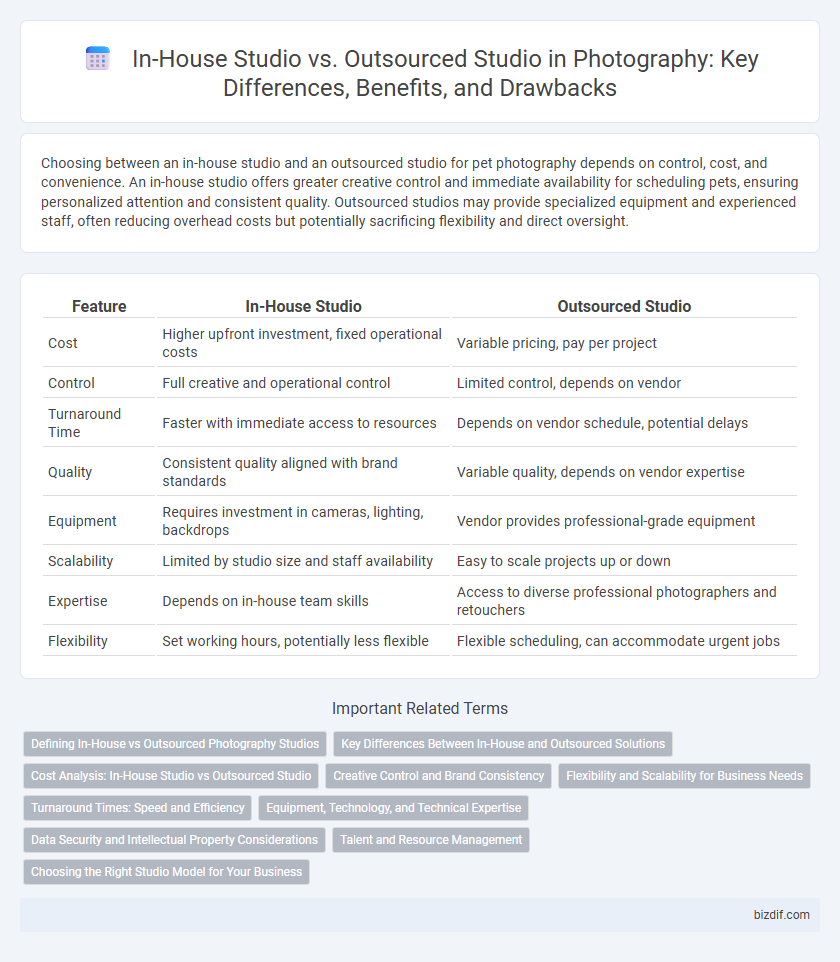Choosing between an in-house studio and an outsourced studio for pet photography depends on control, cost, and convenience. An in-house studio offers greater creative control and immediate availability for scheduling pets, ensuring personalized attention and consistent quality. Outsourced studios may provide specialized equipment and experienced staff, often reducing overhead costs but potentially sacrificing flexibility and direct oversight.
Table of Comparison
| Feature | In-House Studio | Outsourced Studio |
|---|---|---|
| Cost | Higher upfront investment, fixed operational costs | Variable pricing, pay per project |
| Control | Full creative and operational control | Limited control, depends on vendor |
| Turnaround Time | Faster with immediate access to resources | Depends on vendor schedule, potential delays |
| Quality | Consistent quality aligned with brand standards | Variable quality, depends on vendor expertise |
| Equipment | Requires investment in cameras, lighting, backdrops | Vendor provides professional-grade equipment |
| Scalability | Limited by studio size and staff availability | Easy to scale projects up or down |
| Expertise | Depends on in-house team skills | Access to diverse professional photographers and retouchers |
| Flexibility | Set working hours, potentially less flexible | Flexible scheduling, can accommodate urgent jobs |
Defining In-House vs Outsourced Photography Studios
In-house photography studios operate within a company, providing dedicated, consistent creative control and immediate access to brand-specific assets. Outsourced photography studios function as external vendors, offering diverse expertise and scalability but less direct oversight over style and workflow. Choosing between in-house and outsourced studios depends on priorities like budget, speed, quality control, and the need for brand alignment.
Key Differences Between In-House and Outsourced Solutions
In-house studios offer complete control over the creative process, enabling faster turnaround times and tailored brand consistency through dedicated resources. Outsourced studios provide access to diverse expertise and advanced technology without the overhead costs of staffing and equipment maintenance. Key differences include cost management, flexibility in scaling projects, and the level of direct collaboration with photographers and creative teams.
Cost Analysis: In-House Studio vs Outsourced Studio
In-house studios often incur fixed costs such as equipment purchase, maintenance, and dedicated staff salaries, which can lead to higher initial investments but lower per-shoot expenses over time. Outsourced studios typically operate on a pay-per-project basis, eliminating overhead costs and offering scalability but potentially increasing costs for frequent or high-volume photography needs. A thorough cost analysis should consider factors like project frequency, quality control, turnaround time, and hidden expenses to determine which option aligns better with a company's budget and operational goals.
Creative Control and Brand Consistency
In-house studios offer unparalleled creative control by enabling direct oversight of every visual element, ensuring strict adherence to brand guidelines and a cohesive aesthetic across all projects. Outsourced studios may bring specialized expertise but often risk inconsistencies due to limited integration with internal brand strategies and communication gaps. Maintaining brand consistency is critical for consumer trust, making in-house solutions preferable for companies prioritizing tightly controlled, unified creative output.
Flexibility and Scalability for Business Needs
In-house studios offer greater flexibility for businesses by allowing real-time adjustments to shoots and immediate access to equipment and personnel. Outsourced studios provide scalability advantages, enabling companies to handle varying project demands without investing in permanent resources or infrastructure. Choosing between the two depends on the business's need for dynamic control versus the ability to expand production capacity efficiently.
Turnaround Times: Speed and Efficiency
In-house photography studios typically offer faster turnaround times due to direct control over the workflow and immediate access to equipment and staff, enhancing speed and efficiency in project delivery. Outsourced studios may experience delays caused by communication lags, shipping times, and scheduling conflicts, which can extend the overall timeline. Companies prioritizing rapid project completion and tight deadlines often benefit from the streamlined processes inherent in in-house studios.
Equipment, Technology, and Technical Expertise
In-house studios offer direct control over cutting-edge equipment and foster continuous technical expertise development within the team, ensuring tailored, high-quality photography results. Outsourced studios provide access to a broader range of specialized technology and experienced professionals without the overhead cost of maintaining equipment. Choosing between in-house and outsourced studios depends on balancing investment in proprietary technology and the flexibility gained from external technical resources.
Data Security and Intellectual Property Considerations
In-house studios offer superior control over data security and intellectual property by keeping sensitive images and client information within the organization's protected environment, minimizing risks of breaches or unauthorized use. Outsourced studios may pose increased vulnerabilities due to external access, but choosing partners with strict confidentiality agreements and robust cybersecurity measures can mitigate these risks. Ensuring clear intellectual property rights and data handling protocols in contracts is essential to protect creative works and proprietary data in both scenarios.
Talent and Resource Management
In-house studios provide direct control over talent recruitment, fostering consistent skill development and aligning photographers' expertise with brand vision. Outsourced studios offer access to diverse specialists and cutting-edge equipment, enhancing flexibility and scalability for varying project demands. Effective resource management balances cost efficiency with quality output, ensuring optimal allocation of personnel and technology to meet production goals.
Choosing the Right Studio Model for Your Business
Choosing the right studio model for your photography business depends on factors like budget, control over creative output, and turnaround time. In-house studios offer direct oversight and consistent brand representation, while outsourced studios provide flexibility and access to diverse expertise without long-term commitments. Evaluating project volume and desired quality levels helps determine whether in-house investment or outsourcing maximizes efficiency and profitability.
In-House Studio vs Outsourced Studio Infographic

 bizdif.com
bizdif.com